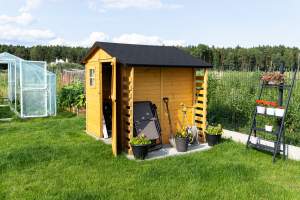
Living a sustainable lifestyle is about making choices that are mindful of the environment, reducing waste, conserving resources, and promoting a healthier planet. Whether you’re new to sustainability or looking for ways to make more eco-friendly changes, starting a sustainable lifestyle doesn’t have to be overwhelming. Small, intentional steps can make a significant impact over time. This beginner’s guide will help you get started on your journey toward living more sustainably.
1. Reduce Single-Use Plastics
One of the easiest and most impactful ways to start living sustainably is by reducing your use of single-use plastics. These items, such as plastic bags, bottles, and straws, contribute significantly to pollution and take hundreds of years to decompose in landfills.
How to reduce single-use plastics:
- Invest in reusable shopping bags and carry them with you when you go grocery shopping or run errands.
- Switch to a reusable water bottle and coffee cup instead of using disposable ones.
- Use stainless steel or silicone straws instead of plastic ones, and carry them with you when you’re on the go.
Pro tip:
- Keep reusable bags and containers in your car or by the door so they’re always on hand when you leave the house.
2. Adopt a Plant-Based Diet
Reducing your consumption of animal products can significantly lower your carbon footprint, as animal agriculture is a major contributor to greenhouse gas emissions and deforestation. You don’t have to go fully vegan to make a difference—starting with one or two plant-based meals per week can have a positive environmental impact.
How to incorporate plant-based meals:
- Try “Meatless Mondays” or experiment with plant-based recipes, such as vegetable stir-fries, lentil soups, or bean-based tacos.
- Use plant-based protein sources like beans, lentils, tofu, and tempeh in place of meat.
- Explore plant-based alternatives for dairy products, such as almond milk, oat milk, or vegan cheese.
Pro tip:
- Start by substituting animal products in your favorite recipes with plant-based options, and gradually increase the number of plant-based meals you eat.
3. Conserve Energy at Home
Energy conservation is an important part of living sustainably, as reducing your energy consumption helps lower your household’s carbon footprint. Making small changes in how you use electricity can lead to significant savings on both energy and utility bills.
How to conserve energy:
- Switch to energy-efficient light bulbs, such as LED bulbs, which use less electricity and last longer than traditional incandescent bulbs.
- Unplug electronic devices when they’re not in use to avoid “phantom” energy use.
- Set your thermostat a few degrees lower in the winter and higher in the summer to save on heating and cooling costs.
Pro tip:
- Consider investing in a smart thermostat that automatically adjusts the temperature based on your schedule and preferences, helping you save energy without thinking about it.
4. Minimize Water Waste
Water conservation is essential for sustainability, especially in regions prone to droughts or water shortages. By making mindful choices about water usage, you can reduce waste and help preserve this vital resource.
How to reduce water waste:
- Fix leaky faucets and pipes to prevent unnecessary water loss.
- Install low-flow showerheads and faucets to reduce water usage without sacrificing water pressure.
- Take shorter showers and turn off the tap while brushing your teeth or washing dishes.
Pro tip:
- Collect rainwater for watering plants or gardens, reducing the need for tap water and conserving resources.
5. Support Sustainable Fashion
The fashion industry is one of the most polluting industries in the world, contributing to water waste, carbon emissions, and unethical labor practices. By making more conscious choices about the clothing you buy, you can reduce your environmental impact and support sustainable brands.
How to embrace sustainable fashion:
- Shop secondhand at thrift stores, online resale platforms, or vintage shops to give pre-loved clothing a new life.
- Invest in high-quality, ethically made clothing that lasts longer and reduces the need for frequent replacements.
- Participate in clothing swaps with friends or family to refresh your wardrobe without buying new items.
Pro tip:
- Avoid fast fashion, which often produces low-quality items with a short lifespan. Instead, focus on buying fewer, better-quality pieces that you can wear for years.
6. Reduce Food Waste
Food waste is a significant environmental issue, contributing to methane emissions in landfills. By being mindful of how much food you buy, cook, and consume, you can help reduce waste and make a positive impact on the environment.
How to reduce food waste:
- Plan meals in advance and create a grocery list to avoid buying more food than you need.
- Store leftovers properly and use them for future meals instead of throwing them away.
- Compost food scraps, such as fruit and vegetable peels, to reduce the amount of organic waste that ends up in landfills.
Pro tip:
- Get creative with leftovers by turning them into new dishes, such as soups, stir-fries, or salads.
7. Choose Eco-Friendly Cleaning Products
Many conventional cleaning products contain harmful chemicals that can pollute the environment and pose health risks. Switching to eco-friendly cleaning products is a simple way to make your home more sustainable and protect both your health and the planet.
How to switch to eco-friendly cleaners:
- Look for cleaning products labeled as biodegradable, non-toxic, or made from natural ingredients.
- Use household items like vinegar, baking soda, and lemon as natural cleaning agents for everything from countertops to bathrooms.
- Purchase concentrated cleaning solutions in reusable containers to reduce plastic waste.
Pro tip:
- Make your own cleaning products using simple ingredients like water, vinegar, and essential oils for an effective, eco-friendly solution.
8. Reduce, Reuse, Recycle
The classic “reduce, reuse, recycle” mantra is a cornerstone of sustainable living. By focusing on reducing consumption, reusing items when possible, and recycling responsibly, you can help minimize waste and conserve resources.
How to follow the 3 Rs:
- Reduce: Be mindful of your consumption habits and only purchase what you truly need. Avoid excessive packaging and choose products with minimal waste.
- Reuse: Find creative ways to repurpose items before discarding them, such as using glass jars for storage or old clothes for cleaning rags.
- Recycle: Familiarize yourself with your local recycling guidelines to ensure you’re recycling materials correctly and efficiently.
Pro tip:
- Start small by focusing on one area of your life, such as reducing plastic use, and gradually incorporate more sustainable practices.
9. Opt for Public Transportation or Carpooling
Transportation is one of the largest sources of greenhouse gas emissions. By reducing your reliance on personal vehicles and opting for public transportation, biking, or carpooling, you can lower your carbon footprint.
How to reduce your transportation impact:
- Use public transportation, such as buses or trains, whenever possible to reduce the number of cars on the road.
- Carpool with coworkers, friends, or family to save gas and reduce emissions.
- Walk or bike to nearby destinations for a zero-emission alternative to driving.
Pro tip:
- If you need to drive, consider switching to a fuel-efficient or electric vehicle to minimize your environmental impact.
10. Educate Yourself and Others
Living sustainably is an ongoing process of learning and adapting. By staying informed about environmental issues and sharing your knowledge with others, you can contribute to a broader movement toward sustainability.
How to continue learning:
- Follow sustainability blogs, podcasts, or documentaries to stay up-to-date on the latest eco-friendly practices and trends.
- Engage with your community by participating in local environmental initiatives, such as beach cleanups, tree planting, or recycling programs.
- Share your sustainable lifestyle journey with friends and family to inspire others to make eco-friendly changes.
Pro tip:
- Start small and focus on progress, not perfection. Every sustainable choice you make contributes to a healthier planet, and inspiring others multiplies that impact.
Starting a sustainable lifestyle is about making mindful choices that benefit both you and the planet. By reducing waste, conserving resources, and adopting eco-friendly habits, you can take small steps toward creating a more sustainable future. Whether you’re focusing on reducing plastic use, conserving water, or supporting ethical fashion, every effort counts. The key to success is consistency and embracing sustainability as a way of life, not just a one-time goal.







